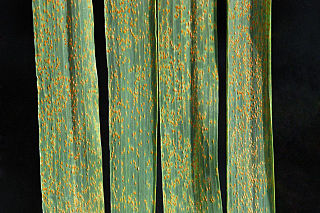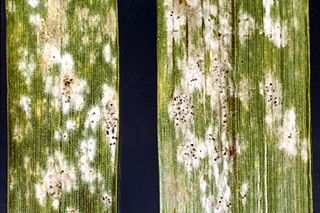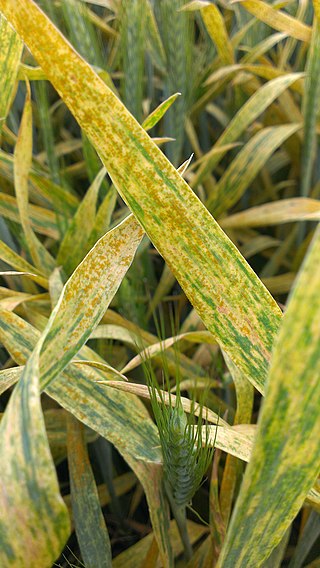Related Research Articles

Rusts are fungal plant pathogens of the order Pucciniales causing plant fungal diseases.

Qo inhibitors (QoI), or quinone outside inhibitors, are a group of fungicides used in agriculture. Some of these fungicides are among the most popular in the world. QoI are chemical compounds which act at the quinol outer binding site of the cytochrome bc1 complex.

Stem rust, also known as cereal rust, black rust, red rust or red dust, is caused by the fungus Puccinia graminis, which causes significant disease in cereal crops. Crop species that are affected by the disease include bread wheat, durum wheat, barley and triticale. These diseases have affected cereal farming throughout history. The annual recurrence of stem rust of wheat in North Indian plains was discovered by K.C. Mehta. Since the 1950s, wheat strains bred to be resistant to stem rust have become available. Fungicides effective against stem rust are available as well.

Wheat leaf rust is a fungal disease that affects wheat, barley, rye stems, leaves and grains. In temperate zones it is destructive on winter wheat because the pathogen overwinters. Infections can lead up to 20% yield loss. The pathogen is a Puccinia rust fungus. It is the most prevalent of all the wheat rust diseases, occurring in most wheat-growing regions. It causes serious epidemics in North America, Mexico and South America and is a devastating seasonal disease in India. P. triticina is heteroecious, requiring two distinct hosts.

Blumeria graminis is a fungus that causes powdery mildew on grasses, including cereals. It is the only species in the genus Blumeria. It has also been called Erysiphe graminis and Oidium monilioides or Oidium tritici.
Spot blotch is a leaf disease of wheat caused by Cochliobolus sativus. Cochliobolus sativus also infects other plant parts and in conjunction with other pathogens causes common root rot and black point.

Pyrenophora tritici-repentis (teleomorph) and Drechslera tritici-repentis (anamorph) is a necrotrophic plant pathogen of fungal origin, phylum Ascomycota. The pathogen causes a disease originally named yellow spot but now commonly called tan spot, yellow leaf spot, yellow leaf blotch or helminthosporiosis. At least eight races of the pathogen are known to occur based on their virulence on a wheat differential set.

Zymoseptoria tritici, synonyms Septoria tritici, Mycosphaerella graminicola, is a species of filamentous fungus, an ascomycete in the family Mycosphaerellaceae. It is a wheat plant pathogen causing septoria leaf blotch that is difficult to control due to resistance to multiple fungicides. The pathogen today causes one of the most important diseases of wheat.

Phaeosphaeria nodorum is a major fungal pathogen of wheat, causing the disease Septoria nodorum blotch. It is a member of the Dothideomycetes, a large fungal taxon that includes many important plant pathogens affecting all major crop plant families.

Ascochyta is a genus of ascomycete fungi, containing several species that are pathogenic to plants, particularly cereal crops. The taxonomy of this genus is still incomplete. The genus was first described in 1830 by Marie-Anne Libert, who regarded the spores as minute asci and the cell contents as spherical spores. Numerous revisions to the members of the genus and its description were made for the next several years. Species that are plant pathogenic on cereals include, A. hordei, A. graminea, A. sorghi, A. tritici. Symptoms are usually elliptical spots that are initially chlorotic and later become a necrotic brown. Management includes fungicide applications and sanitation of diseased plant tissue debris.

Wheat yellow rust, also known as wheat stripe rust, is one of the three major wheat rust diseases, along with stem rust of wheat and leaf rust.
Epoxiconazole is a fungicide active ingredient from the class of azoles developed to protect crops. In particular, the substance inhibits the metabolism of fungi cells infesting useful plants, and thereby prevents the growth of the mycelia. Epoxiconazole also limits the production of conidia (mitospores). Epoxiconazole was introduced to the market by BASF SE in 1993 and can be found in many products and product mixtures targeting a large number of pathogens in various crops. Crops are, for example, cereals, soybeans, banana, rice, coffee, turnips, and red as well as sugar beets.
Ruth Florence Allen (1879–1963) was an American botanist and plant pathologist and the first woman to earn her Ph.D. in botany from the University of Wisconsin. Her doctorate research focused on the reproduction and cell biology of ferns, particularly the phenomenon of apogamy. Later in her career, Allen shifted her focus to plant pathology. Her major contribution to the field of mycology was furthering the understanding of rust fungi, a group of economically important plant pathogens. Allen completed many studies on Puccinia graminis, once considered a catastrophically damaging disease-causing agent in cereal crops before the discovery of current management measures.

Margaret Brown Newton was a Canadian plant pathologist and mycologist internationally renowned for her pioneering research in stem rust Puccinia graminis, particularly for its effect on the staple Canadian agricultural product wheat.

Fluxapyroxad is a broad-spectrum pyrazole-carboxamide fungicide used on a large variety of commercial crops. It stunts fungus growth by inhibiting the succinate dehydrogenase (SQR) enzyme. Application of fluxapyroxad helps prevent many wilts and other fungal infections from taking hold. As with other systemic pesticides that have a long chemical half-life, there are concerns about keeping fluxapyroxad out of the groundwater, especially when combined with pyraclostrobin. There is also concern that some fungi may develop resistance to fluxapyroxad.

Sedaxane is a broad spectrum fungicide used as a seed treatment in agriculture to protect crops from fungal diseases. It was first marketed by Syngenta in 2011 using their brand name Vibrance. The compound is an amide which combines a pyrazole acid with an aryl amine to give an inhibitor of succinate dehydrogenase.
Sarrah Ben M'barek-Ben Romdhane is a Tunisian-Dutch crop researcher. She works on developing fungus-resistant wheat strains to reduce the toll of Mycosphaerella graminicola on yields.

Boscalid is a broad spectrum fungicide used in agriculture to protect crops from fungal diseases. It was first marketed by BASF in 2002 using their brand name Endura. The compound is an biphenyl amide derived inhibitor of succinate dehydrogenase.

Pydiflumetofen is a broad spectrum fungicide used in agriculture to protect crops from fungal diseases. It was first marketed by Syngenta in 2016 using their brand name Miravis. The compound is an amide which combines a pyrazole acid with a substituted phenethylamine to give an inhibitor of succinate dehydrogenase.

3-(Difluoromethyl)-1-methyl-1H-pyrazole-4-carboxylic acid is a chemical compound which is used commercially as an intermediate to seven fungicides which act by inhibition of succinate dehydrogenase (SDHI). It consists of a pyrazole ring with difluoromethyl, methyl and carboxylic acid groups attached in specific positions.
References
- ↑ "Wheat disease management guide" (PDF). HGCA, Agriculture and Horticulture Development Board. 2012. Archived (PDF) from the original on 28 October 2014.
- ↑ "Cereals/Seed Treatment Trials: Efficacy of seed treatment fungicides in spring barley and spring wheat" (PDF). MTT Agrifood Research Finland. 23 November 2012. Archived (PDF) from the original on 28 October 2014.
- ↑ Smith, J.; Grimmer, M.; Waterhouse, S. & Paveley, N. (2013). "Quantifying the non-fungicidal effects of foliar applications of fluxapyroxad (Xemium) on stomatal conductance, water use efficiency and yield in winter wheat". Communications in Agricultural and Applied Biological Sciences. 78 (3): 523–535. PMID 25151827. Abstract
- ↑ Rowell, J. B. (1976). "Controlof Leaf Rust on Spring Wheat by Seed Treatment with 4-N-butyl-1.2.4-triazole" (PDF). Phytopathology. 66 (9): 1129–1134. doi:10.1094/phyto-66-1129. Archived (PDF) from the original on 5 February 2012.
